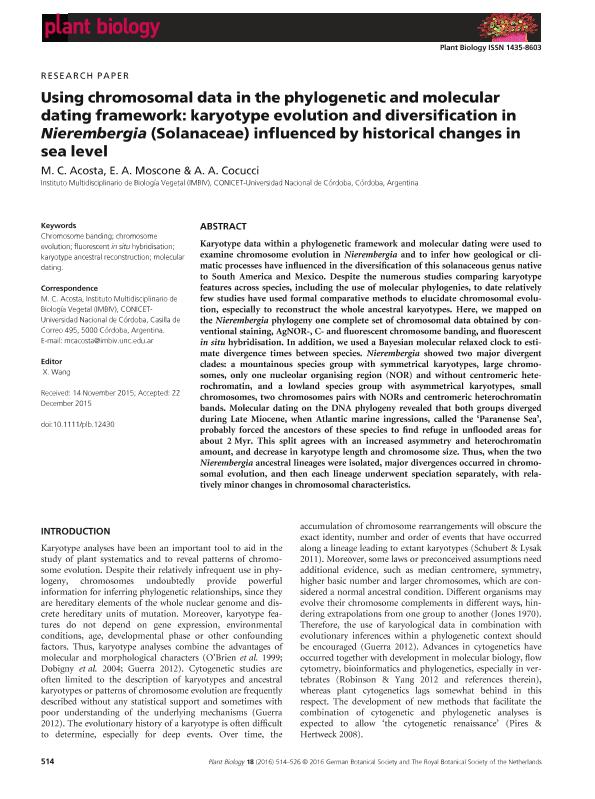Mostrar el registro sencillo del ítem
dc.contributor.author
Acosta, María Cristina

dc.contributor.author
Moscone, Eduardo Alberto

dc.contributor.author
Cocucci, Andrea Aristides

dc.date.available
2017-06-09T15:46:18Z
dc.date.issued
2016-03
dc.identifier.citation
Acosta, María Cristina; Moscone, Eduardo Alberto; Cocucci, Andrea Aristides; Using chromosomal data in the phylogenetic and molecular dating framework: Karyotype evolution and diversification in Nierembergia (Solanaceae) influenced by historical changes in sea level; Wiley Blackwell Publishing, Inc; Plant Biology; 18; 3; 3-2016; 514-526
dc.identifier.issn
1435-8603
dc.identifier.uri
http://hdl.handle.net/11336/17878
dc.description.abstract
Karyotype data within a phylogenetic framework and molecular dating were used to examine chromosome evolution in Nierembergia and to infer how geological or climatic processes have influenced in the diversification of this solanaceous genus native to South America and Mexico. Despite the numerous studies comparing karyotype features across species, including the use of molecular phylogenies, to date relatively few studies have used formal comparative methods to elucidate chromosomal evolution, especially to reconstruct the whole ancestral karyotypes. Here, we mapped on the Nierembergia phylogeny one complete set of chromosomal data obtained by conventional staining, AgNOR-, C- and fluorescent chromosome banding, and fluorescent in situ hybridisation. In addition, we used a Bayesian molecular relaxed clock to estimate divergence times between species. Nierembergia showed two major divergent clades: a mountainous species group with symmetrical karyotypes, large chromosomes, only one nucleolar organising region (NOR) and without centromeric heterochromatin, and a lowland species group with asymmetrical karyotypes, small chromosomes, two chromosomes pairs with NORs and centromeric heterochromatin bands. Molecular dating on the DNA phylogeny revealed that both groups diverged during Late Miocene, when Atlantic marine ingressions, called the 'Paranense Sea', probably forced the ancestors of these species to find refuge in unflooded areas for about 2 Myr. This split agrees with an increased asymmetry and heterochromatin amount, and decrease in karyotype length and chromosome size. Thus, when the two Nierembergia ancestral lineages were isolated, major divergences occurred in chromosomal evolution, and then each lineage underwent speciation separately, with relatively minor changes in chromosomal characteristics.
dc.format
application/pdf
dc.language.iso
eng
dc.publisher
Wiley Blackwell Publishing, Inc

dc.rights
info:eu-repo/semantics/openAccess
dc.rights.uri
https://creativecommons.org/licenses/by-nc-sa/2.5/ar/
dc.subject
Karyotype Ancestral Reconstruction
dc.subject
Chromosome Evolution
dc.subject
Molecular Dating
dc.subject
Fluorescent in Situ Hybridization
dc.subject
Chromosome Banding
dc.subject.classification
Ciencias de las Plantas, Botánica

dc.subject.classification
Ciencias Biológicas

dc.subject.classification
CIENCIAS NATURALES Y EXACTAS

dc.title
Using chromosomal data in the phylogenetic and molecular dating framework: Karyotype evolution and diversification in Nierembergia (Solanaceae) influenced by historical changes in sea level
dc.type
info:eu-repo/semantics/article
dc.type
info:ar-repo/semantics/artículo
dc.type
info:eu-repo/semantics/publishedVersion
dc.date.updated
2017-06-06T14:42:18Z
dc.identifier.eissn
1438-8677
dc.journal.volume
18
dc.journal.number
3
dc.journal.pagination
514-526
dc.journal.pais
Reino Unido

dc.journal.ciudad
Londres
dc.description.fil
Fil: Acosta, María Cristina. Consejo Nacional de Investigaciones Científicas y Técnicas. Centro Científico Tecnológico Conicet - Córdoba. Instituto Multidisciplinario de Biología Vegetal. Universidad Nacional de Córdoba. Facultad de Ciencias Exactas Físicas y Naturales. Instituto Multidisciplinario de Biología Vegetal; Argentina
dc.description.fil
Fil: Moscone, Eduardo Alberto. Consejo Nacional de Investigaciones Científicas y Técnicas. Centro Científico Tecnológico Conicet - Córdoba. Instituto Multidisciplinario de Biología Vegetal. Universidad Nacional de Córdoba. Facultad de Ciencias Exactas Físicas y Naturales. Instituto Multidisciplinario de Biología Vegetal; Argentina
dc.description.fil
Fil: Cocucci, Andrea Aristides. Consejo Nacional de Investigaciones Científicas y Técnicas. Centro Científico Tecnológico Conicet - Córdoba. Instituto Multidisciplinario de Biología Vegetal. Universidad Nacional de Córdoba. Facultad de Ciencias Exactas Físicas y Naturales. Instituto Multidisciplinario de Biología Vegetal; Argentina
dc.journal.title
Plant Biology

dc.relation.alternativeid
info:eu-repo/semantics/altIdentifier/url/http://onlinelibrary.wiley.com/doi/10.1111/plb.12430/abstract
dc.relation.alternativeid
info:eu-repo/semantics/altIdentifier/doi/http://dx.doi.org/10.1111/plb.12430
Archivos asociados
